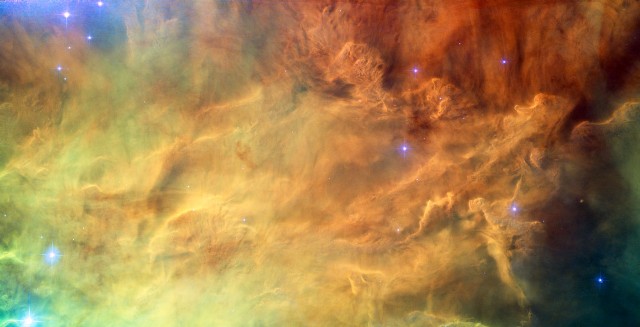Celestial Clouds Poem by Harley White
Celestial Clouds
Nebulae make for magnificent views,
like one in Archer at Milky Way's heart,
a wispy pastiche lit with vibrant hues
in which ultraviolet rays take part
from newly-born stars that shine on the skies
nearby, in quasi sidereal tides
ever ebbing and flowing, with their rise
forming breakers a stellar surfer rides.
Waves undulating on cosmic lagoon
in this region of Sagittarius
on colossal canvas seem to be strewn
in billowy strokes multifarious.
Still all's an illusion of gas and dust,
fashioned in delicate sculptural casts
over which a great artist might have fussed
with finesse for astral enthusiasts.
It's four to five thousand light-years from us
and stretches one hundred light-years across,
as collapsing hydrogen vapors thus
fabricate infant stars aglow with gloss
along dusty lanes traversing the gas.
Such fanciful scenes defy portrayals
and send astronomic gazers en masse
on cosmic quests for stelliferous grails…
There's no end to wonders beyond our range
of vision that science can scrutinize.
Nonetheless, many marvels just as strange
exist on this planet before our eyes.
Seeking to fathom the heavens is grand
if it stirs a sense of the precious worth
of living beings in seas or on land—
for we must look after what's here on earth!

The image shows a close-up shot of the center of the Lagoon Nebula (Messier 8) clearly shows the delicate structures formed when the powerful radiation of young stars interacts with the hydrogen cloud they formed from. This image was created from exposures taken with the Wide Field Channel of the Advanced Camera for Surveys on Hubble. Light from glowing hydrogen (through the F658N filter) is colored red. Light from ionized nitrogen (through the F660N filter) is colored green and light through a yellow filter (F550M) is colored blue. The exposure times through each filter are 1560 s,1600 s and 400 s respectively. The blue-white flare at the upper-left of the image is scattered light from a bright star just outside the field of view. The field of view is about 3.3 by 1.7 arcminutes.
This structure is prominent in wide-field images, but cannot be seen in this close-up. However the strange billowing shapes and sandy texture visible in this image make the Lagoon Nebula's watery name eerily appropriate from this viewpoint too. Located four to five thousand light-years away, in the constellation of Sagittarius (the Archer) , Messier 8 is a huge region of star birth that stretches across one hundred light-years. Clouds of hydrogen gas are slowly collapsing to form new stars, whose bright ultraviolet rays then light up the surrounding gas in a distinctive shade of red. The wispy tendrils and beach-like features of the nebula are not caused by the ebb and flow of tides, but rather by ultraviolet radiation's ability to erode and disperse the gas and dust into the distinctive shapes that we see.
Credit: NASA, ESA.
This poem has not been translated into any other language yet.
I would like to translate this poem